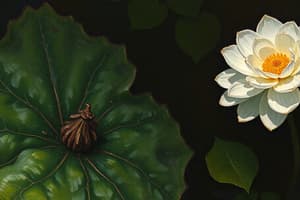Podcast
Questions and Answers
Which of the following are included in the five characteristics of life? (Select all that apply)
Which of the following are included in the five characteristics of life? (Select all that apply)
- Hibernation
- Reproduction (correct)
- Adapt/Evolve (correct)
- Cells (correct)
What is the basic unit of structure and function in living things?
What is the basic unit of structure and function in living things?
Cells
What defines multicellular organisms?
What defines multicellular organisms?
Consisting of more than one cell
What is abiogenesis?
What is abiogenesis?
What is the difference between biogenesis and abiogenesis?
What is the difference between biogenesis and abiogenesis?
What is metabolism?
What is metabolism?
What does the process of anabolism involve?
What does the process of anabolism involve?
How do heterotrophs obtain food?
How do heterotrophs obtain food?
What is homeostasis?
What is homeostasis?
What is a stimulus?
What is a stimulus?
What is natural selection?
What is natural selection?
The five characteristics of life include: cells, obtain and use energy, reproduction, respond to the environment, and _____.
The five characteristics of life include: cells, obtain and use energy, reproduction, respond to the environment, and _____.
What are the stages in the diagram of life?
What are the stages in the diagram of life?
Flashcards are hidden until you start studying
Study Notes
Five Characteristics of Life
- Life is defined by five key features: Cells, Obtain and Use Energy, Reproduction, Respond to the Environment, and Adapt/Evolve.
Cells
- Fundamental unit of structure and function in living organisms, e.g., bone cells.
- Multicellular organisms consist of multiple cells (e.g., humans, lions).
- Unicellular organisms consist of a single cell (e.g., bacteria, archaea).
Levels of Organization
- Cells form the basic units of living things (e.g., skin cells, bone cells).
- Tissues are collections of similar cells (e.g., nerve and muscle tissues).
- Organs are composed of tissues performing specific functions (e.g., heart).
- Organ Systems are groups of organs working together (e.g., cardiovascular system).
- Organisms are individual living entities capable of responding and reproducing (e.g., bacteria, humans).
Reproduction
- Sexual reproduction involves the fusion of gametes to create a new organism.
- Asexual reproduction allows a single organism to create offspring independently.
- Essential for producing new organisms of the same type.
Abiogenesis
- Refers to the concept of life originating from inorganic matter.
Biogenesis
- The process by which living organisms arise from other living organisms.
Obtain and Use Energy
- Metabolism encompasses all chemical reactions within an organism, essential for maintaining life.
Anabolism
- The process of synthesizing complex molecules from simpler ones, e.g., photosynthesis.
Catabolism
- The breakdown of complex substances into simpler components, e.g., conversion of proteins to amino acids or glucose to ATP.
Autotroph/Producer
- Organisms that create their own food through processes like photosynthesis (e.g., plants, algae).
Heterotroph/Consumer
- Organisms that obtain food by consuming other organisms (e.g., lions, tigers, humans).
Respond to the Environment
- Irritability describes an organism's ability to react to environmental stimuli.
Stimulus
- Any environmental factor that elicits a response from an organism (e.g., light, temperature, sound).
Response
- The action taken by an organism in reaction to a stimulus.
Homeostasis
- The ability of an organism to maintain stable internal conditions despite external changes.
Adapt and Evolve
- Adaptation is an inherited characteristic that enhances an organism's survival and reproductive success.
Evolution
- Refers to genetic changes in a species over time, illustrated by examples like the evolution of color traits in beetles.
Natural Selection
- The principle that organisms with advantageous traits are more likely to survive and reproduce, leading to evolutionary changes.
Diagram of Life
- Life progresses through stages: Birth/Growth & Development, Maturity (reproductive capability), Decline, and Death.
Studying That Suits You
Use AI to generate personalized quizzes and flashcards to suit your learning preferences.




